Transcription of FCE 311 - Geotechnical Engineering LECTURE NOTES FINAL2
1 University of Nairobi Department of civil and Construction Engineering FCE 311 Geotechnical Engineering 1 LECTURE NOTES DR. NYAMBANE OSANO 2012 FCE 311 Geotechnical Engineering I OSN - LECTURE NOTES University of Nairobi Page i TABLE OF CONTENTS 1 OVERVIEW .. 1 COURSE DESCRIPTION 1 PREREQUISITE 1 STUDENT LEARNING OUTCOME 1 TEACHING METHODOLOGY AND TECHNIQUES 1 REQUIRED TEXT BOOKS 1 2 INTRODUCTION TO SOIL MECHANICS .. 2 DEFINITION OF SOIL 2 SOIL MECHANICS AND Geotechnical Engineering 2 3 SOIL FORMATION .. 4 DEFINITION 4 WEATHERING 4 INTRODUCTION 4 PHYSICAL WEATHERING 4 CHEMICAL WEATHERING 4 RESIDUAL AND ALLUVIAL SOILS 5 RESIDUAL SOILS 5 ALLUVIAL SOILS 5 4 CLAY MINERALOGY.
2 6 INTRODUCTION 6 ATOMIC AND MOLECULAR BONDS 6 INTRODUCTION 6 IONIC BOND 6 COVALENT BOND 7 HYDROGEN BOND 7 VAN DER WAALS BONDS 8 BASIC STRUCTURAL UNITS OF CLAY MINERALS 9 INTRODUCTION 9 SILICA UNIT 9 ALUMINIUM (OR MAGNESIUM) OCTAHEDRAL UNIT 10 TYPES OF CLAY MINERALS 11 INTRODUCTION 11 KAOLINITE 11 FCE 311 Geotechnical Engineering I OSN - LECTURE NOTES University of Nairobi Page ii MONTMORILLONITE 12 ILLITE 12 SOIL STRUCTURES 13 INTRODUCTION 13 TYPES OF SOIL STRUCTURES 13 5 BASIC PROPERTIES .. 17 SOME USEFUL TERMS AND ASSOCIATED SYMBOLS 17 PHASE RELATIONSHIP 18 PHASE DIAGRAM 18 VOID RATIO (E) 19 MOISTURE CONTENT (WATER CONTENT) (W) 19 POROSITY (N) 19 SPECIFIC VOLUME (V) 19 RELATIVE DENSITY (SPECIFIC GRAVITY) (GS) 20 DEGREE OF SATURATION (SR) 20 AIR CONTENT (A) 20 DENSITY OF SOLIDS ( S) 21 BULK DENSITY ( ) 21 SATURATED DENSITY ( SAT) 22 DRY DENSITY ( D) 22 DRY UNIT WEIGHT ( DRY) 23 SUBMERGED UNIT WEIGHT ( SUB) 23 6 CONSISTENCY AND PLASTICITY OF SOILS.
3 24 STATE OF CONSISTENCY 24 7 DETERMINATION OF SOIL PROPERTIES BY LABORATORY TESTING .. 27 DETERMINATION OF LIQUID LIMIT 27 CASAGRANDE APPARATUS 27 CONE PENETROMETER APPRATUS 29 DETERMINATION OF PLASTIC LIMIT 30 DETERMINATION OF SHRINKAGE LIMIT 31 ATTERBERG INDICES 32 PLASTICITY INDEX 32 FLOW INDEX, IF 33 TOUGHNESS INDEX 33 CONSISTENCY INDEX 33 LIQUIDITY INDEX 34 USE OF CONSISTENCY LIMITS 34 WATER CONTENT 35 OVEN-DRYING METHOD 35 FCE 311 Geotechnical Engineering I OSN - LECTURE NOTES University of Nairobi Page iii SAND BATH METHOD 35 OTHER METHODS 36 SPECIFIC GRAVITY 36 DETERMINATION OF FIELD DENSITY 38 CORE CUTTER METHOD 38 SAND REPLACEMENT METHOD 40 PARTICLE-SIZE DISTRIBUTION 40 SIEVE ANALYSIS 41 PARTICLE-SIZE DISTRIBUTION CURVES 42 SIEVE ANALYSIS TEST RESULT 43 EXAMPLE PARTICLE SIZE DISTRIBUTION CURVES 44 LIMITATIONS
4 OF SIEVE ANALYSIS 46 8 SOIL DESCRIPTION AND CLASSIFICATION .. 47 INTRODUCTION 47 SOIL DESCRIPTION 47 SOIL CLASSIFICATION SYSTEMS 49 PURPOSE OF SOIL CLASSIFICATION 49 SHORTCOMINGS OF THE CLASSIFICATION SYSTEMS 54 9 SOIL COMPACTION .. 55 INTRODUTION 55 THEORY OF COMPACTION 55 GENERAL 55 VARIATION IN COMPACTION CURVE 57 LABORATORY COMPACTION TESTS 58 FIELD COMPACTION 59 COMPACTION 59 FIELD CONTROL OF COMPACTION 60 SPECIFICATION OF THE FIELD COMPACTED DENSITY 61 FCE 311 Geotechnical Engineering I OSN - LECTURE NOTES UNIVERSITY OF NAIROBI Page 1 1 OVERVIEW COURSE DESCRIPTION This course is an introductory part of Soil Mechanics, which focuses on soil formation, soil structures, physical properties of soils, soil classifications.
5 Soil compaction and permeability. PREREQUISITE None STUDENT LEARNING OUTCOME Upon successful completion of this course, the students should acquire the following knowledge: a) Developed competence in the principles of soil mechanics and application in Engineering practice. b) Ability to list the relevant Engineering properties of soils and their characteristics and describe the factors which control these properties. c) Apply laboratory methods of determining the properties of soils. d) Ability to identify common situations when the soil becomes a factor in an Engineering or environmental problem.
6 E) Ability to apply basic analytical procedures to obtain the Engineering quantity desired and understand their limitations. TEACHING METHODOLOGY AND TECHNIQUES This course relies on lectures and Power Point presentation by the lecturer. Worked examples will be offered. Students will then be required to contribute to discussions based on the explanations and will need to read the corresponding section in the assigned textbook. REQUIRED TEXT BOOKS a) Modern Geotechnical Engineering , CBS Publishers & Distributors, New Dheli b) Geotechnical Engineering (Basics of Soil Mechanics), S.
7 Chand & Company Ltd, New Dheli c) Foundation Engineering Handbook, CBS Publishers & Distributors, New Dheli. FCE 311 Geotechnical Engineering I OSN - LECTURE NOTES UNIVERSITY OF NAIROBI Page 2 2 INTRODUCTION TO SOIL MECHANICS DEFINITION OF SOIL Soil is the relatively loose mass of mineral and organic materials and sediments found above the bedrock, which can be relatively easily broken down into its constituent mineral or organic particles. Fig. 2-1: Soil layers Soil consists of layers of minerals constituents of variable thickness, which differ from the parent materials in the morphological, physical, chemical and mineralogical characteristics, as shown in Fig.
8 2-1. It is thus a natural product of weathering of rocks and decomposition of organic matter. It is an accumulation of individual particles that are bonded together by mechanical or attractive means, the strength of the bonds being a small fraction of the mineral particles. The particles may range from colloidal size to small boulders. Soil can also be referred to as regolith, or loose rock material. SOIL MECHANICS AND Geotechnical Engineering Soil mechanics is a branch of Engineering mechanics that describes the behaviour of soils. Soil mechanics provide the theoretical basis for analysis in Geotechnical Engineering .
9 FCE 311 Geotechnical Engineering I OSN - LECTURE NOTES UNIVERSITY OF NAIROBI Page 3 Geotechnical Engineering is the branch of civil Engineering concerned with the Engineering behaviour of earth materials. It uses principles of soil mechanics, rock mechanics and Engineering geology to investigate subsurface conditions and materials, determine the relevant physical/mechanical and chemical properties of the materials, evaluate stability of natural slopes and man-made soil deposits, access risks posed by site conditions, design earthworks and structure foundations and monitor site conditions, earthwork and foundation construction.
10 A typical Geotechnical Engineering project begins with a review of project needs to define the required material properties. Then follows a site investigation of soil, rock, fault distribution and bedrock properties on and below an area of interest to determine their Engineering properties. Site investigations are needed to gain an understanding of the area in or on which the Engineering will take place. Investigations can include the assessment of the risk to humans, property and the environment from natural hazards such as earthquakes, landslides, soil liquefaction, debris flows and rock falls.







